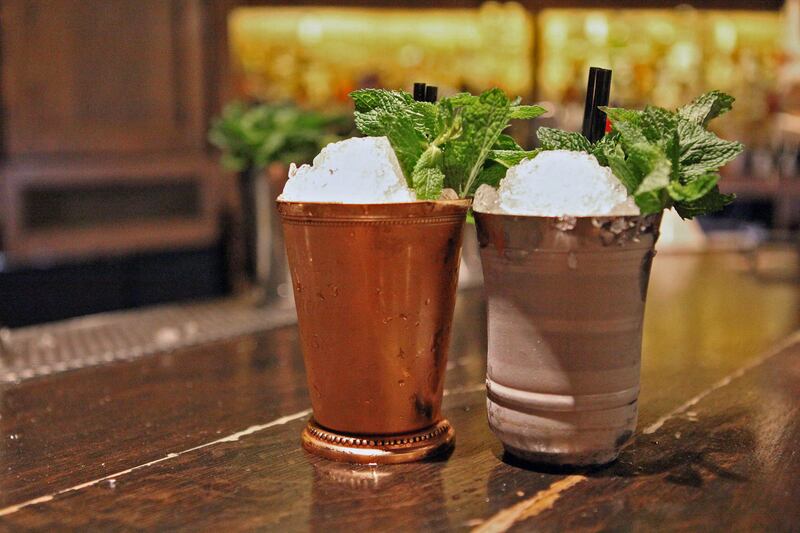Get off a plane at Louisville’s airport and one of the first things you see is a giant ad for Maker’s Mark Bourbon and a Woodford Reserve themed bar.
Is it any wonder why most people think that Kentucky and bourbon are synonymous?
While the whiskey can technically be made anywhere inside American borders, for decades the Bluegrass State has effectively been able to stake claim on the liquor and box out the rest of the country.
Sure, there’s now some competition with distilleries from New York to California making the spirit, but for all intents and purposes the Kentucky name still carries a huge amount of weight with drinkers and bartenders on a bottle label.
So with all eyes on Louisville today for the 142nd running of the Kentucky Derby, it’s the perfect time to look at how the state managed to become the bourbon capitol of the world.
In order to start our investigation, we need to travel back to the origins of whiskey in America and the beginning of the country.
During the early 1800s there were really just a few main spirits available to drink, including gin, rum, brandy and, of course, bourbon.
While these terms refer to specific types of liquor today, according to historian Mike Veach, the author of Kentucky Bourbon Whiskey: An American Heritage, at that time they were used to refer to wider categories.
In fact, “a lot of early things called bourbon were actually rye whiskey or maybe even wheat whiskey,” Veach says.
That, of course, begs one of the great drinking questions of all time: Where does the name bourbon come from? One theory is that it comes from the French Bourbon Kings. (The likelihood of that being true is probably pretty slim.)
Some claim that it comes from Bourbon Street in New Orleans. The idea is that people were looking for the same drink that they enjoyed while down in NOLA. (It’s plausible given that barrels and barrels of whiskey were floated down the Mississippi River, and New Orleans has always boasted an impressive bar scene.)
The final (and most vocal) school of thought is that the whiskey’s name comes from Bourbon County, Kentucky, where bourbon was supposed to have been originally distilled. (The jury is still out on the veracity of this widely circulated claim.)

But what we do know is that, according to Veach, the first reference to bourbon in print was published in an 1821 advertisement that ran in a newspaper in Bourbon County, Kentucky.
Kentucky certainly has the right combination of key attributes to produce excellent whiskey: a plentiful supply of soft water, fertile fields for growing corn and a hot summer and cold winter, which aids the barrel aging process.
As a result, “Kentucky built a big reputation on making the finest bourbon,” says Veach. “The reputation starts just before the Civil War and takes off in the 1870s.”
While plenty of other states, including Indiana and Illinois, boasted large and impressive bourbon distilleries they weren’t able to create the same kind of reputation—so much so that some brands would actually buy whisky in Illinois and rectify it or blend it in Kentucky so they could put Kentucky on the label.
“By 1840s old Bourbon County whiskey was very prized, but you didn’t know where it was from,” Robert Moss, author of the recently published Southern Spirits: Four Hundred Years of Drinking in the American South, with Recipes.
Why bother? Even drinkers then, according to Moss, were willing to pay 20 to 30 percent more for Kentucky bourbon. (Monongahela rye from Pennsylvania also enjoyed that same name recognition and premium pricing.)
Ironically, even Prohibition helped Kentucky establish itself as the center of the bourbon world.
Four of the six companies that were licensed to bottle medicinal whiskey during the famously dry period were based in Kentucky and the two others had facilities in the state. As a result, drinkers continued to associate the area with the whiskey, while distillers in other states were out of business.
Even later in the 1970s and ‘80s—when whiskey sales started to slide and Americans began drinking craft beers, domestic wines, and imported vodka—the distilleries in Kentucky continued to produce bourbon hoping that one day drinkers would rediscover their products. With the rebirth of the cocktail and whiskey, Kentucky has once again taken its place as the king of the bourbon world. Now, with increasing competition, it’s just a question of whether they can hold on to that title.





